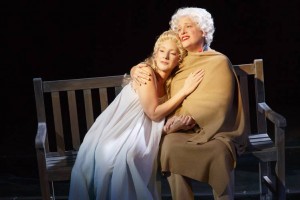 “I doubt if one ever accepts a belief until one urgently needs it.”
“I doubt if one ever accepts a belief until one urgently needs it.”
Christopher Isherwood, Christopher and His Kind
Terry Teachout on the arts in New York City
 I continue to adjust more or less smoothly to life with my new MacBook Air. Alas, nobody’s perfect, and I hit a pothole yesterday with my e-mail program, which proceeded to swallow a half-dozen or so personal messages that I had yet to answer. Most of them I remember, but one or two have slipped my aging mind.
I continue to adjust more or less smoothly to life with my new MacBook Air. Alas, nobody’s perfect, and I hit a pothole yesterday with my e-mail program, which proceeded to swallow a half-dozen or so personal messages that I had yet to answer. Most of them I remember, but one or two have slipped my aging mind.
If you wrote to me for personal reasons at any time in the last week and a half and have so far failed to receive an answer, would you please be so kind as to send your e-mail again? I promise this time to answer it as punctually as possible.
In today’s Wall Street Journal I review two musicals that couldn’t be more different, the New York premiere of First Daughter Suite and the Broadway premiere of Dames at Sea. Here’s an excerpt.
* * *
 Michael John LaChiusa is a singularly gifted, hugely original maker of musical theater who, like Stephen Sondheim before him, insists on going his own idiosyncratic way. While his shows rarely have any obvious commercial appeal, the Public Theater, to its infinite credit, keeps on producing them. Hence “First Daughter Suite,” a quartet of fictional portraits of the daughters and wives of Richard Nixon, Gerald Ford, Jimmy Carter, Ronald Reagan and George Bush the elder. No, it’s not especially political. Instead, Mr. LaChiusa has given us something far more interesting, a four-part dramatic poem about the pathos of unsought fame whose score is as beautiful as anything that Mr. Sondheim ever wrote in his prime.
Michael John LaChiusa is a singularly gifted, hugely original maker of musical theater who, like Stephen Sondheim before him, insists on going his own idiosyncratic way. While his shows rarely have any obvious commercial appeal, the Public Theater, to its infinite credit, keeps on producing them. Hence “First Daughter Suite,” a quartet of fictional portraits of the daughters and wives of Richard Nixon, Gerald Ford, Jimmy Carter, Ronald Reagan and George Bush the elder. No, it’s not especially political. Instead, Mr. LaChiusa has given us something far more interesting, a four-part dramatic poem about the pathos of unsought fame whose score is as beautiful as anything that Mr. Sondheim ever wrote in his prime.
The one-act musicals that make up “First Daughter Suite” vary widely in style. “Happy Pat” is a dark comedy about the White House wedding of Tricia Nixon (Betsy Morgan) in which Pat Nixon (Barbara Walsh) is visited by the censorious ghost of her husband’s Quaker mother (Theresa McCarthy). “Amy Carter’s Fabulous Dream Adventure” is a surreal fantasy in which young Amy (Carly Tamer) takes various Carters and Fords on a fantastic voyage to Iran. “Patti by the Pool” portrays a savage skirmish between Patti Davis (Caissie Levy) and Nancy Reagan (Alison Fraser). In “In the Deep Bosom of the Ocean Buried,” Laura Bush (Rachel Bay Jones) tries to lure Barbara (Mary Testa) onto the campaign trail, not knowing that her mother-in-law is preoccupied by memories of her daughter Robin (Ms. McCarthy), who died of leukemia at the age of four.
What all four acts have in common is that they show us the private lives of a group of women who have paid in variously painful ways for their unseen husbands’ ambitions….
 “Dames at Sea,” the ultra-campy 1966 musical about the you’ll-come-back-a-star backstage movie musicals of the early ’30s, has finally made it to Broadway. I’m not sure why, since the point of the show, which employs just six performers (one of whom plays two parts) and whose original downtown run opened the door to fame for Bernadette Peters, is that it’s a low-budget miniature send-up of the genre. Staging it on Broadway would seem to be somewhat beside the point, though this gussied-up revival, directed and choreographed by Randy Skinner, is nothing if not charming. If you like high-velocity tap dancing, you’ll see (and hear) plenty of it…
“Dames at Sea,” the ultra-campy 1966 musical about the you’ll-come-back-a-star backstage movie musicals of the early ’30s, has finally made it to Broadway. I’m not sure why, since the point of the show, which employs just six performers (one of whom plays two parts) and whose original downtown run opened the door to fame for Bernadette Peters, is that it’s a low-budget miniature send-up of the genre. Staging it on Broadway would seem to be somewhat beside the point, though this gussied-up revival, directed and choreographed by Randy Skinner, is nothing if not charming. If you like high-velocity tap dancing, you’ll see (and hear) plenty of it…
So what’s not to like? Nothing whatsoever—but there isn’t enough to love about “Dames at Sea,” which may have seemed sufficiently witty a half-century ago but has long since been outclassed by the encyclopedically knowing musical-comedy spoofery of “The Drowsy Chaperone.” Compared with that big-brain homage, “Dames at Sea” isn’t much more clever than a college show…
* * *
To read my review of First Daughter Suite, go here.
To read my review of Dames at Sea, go here.
In today’s Wall Street Journal “Sightings” column I discuss adaptations of well-known works of art that are better than (or as good as) the originals. Here’s an excerpt.
* * *
If you’re the kind of adventure-loving theatergoer who can’t think of a good reason to see “The Gin Game” again, you might want to check out New Yiddish Rep’s off-Broadway production of “Death of a Salesman,” which runs through Nov. 22 at the Castillo Theatre. Why? Because it’s being done in Yiddish, the amalgam of Hebrew and German that was heard in the ghettoes of Central Europe prior to the Holocaust and continues to be spoken by Hasidic and Orthodox Jews throughout the world.
 I have yet to see this staging, but it’s clear from reading the script, which was translated in 1951 by Joseph Buloff, that “Death of a Salesman” has profited immensely from the change in languages. Even though Willy and Linda Loman are as self-evidently Jewish as bagels and lox, Miller deliberately deracinated their characters on the page to make their plight seem more universal to Gentile audiences. That’s why their lines sound more authentic in Yiddish (which you don’t have to speak to follow the production—it uses English-language supertitles). Instead of the inflated pseudo-poetry of Miller’s original text, you get the guttural lilt of a homely tongue that comes naturally to such beleaguered souls. In Yiddish, Linda’s notoriously clumsy “Attention, attention must be finally paid to such a person” has the stark ring of a death sentence: “Achtung gebn af im.”
I have yet to see this staging, but it’s clear from reading the script, which was translated in 1951 by Joseph Buloff, that “Death of a Salesman” has profited immensely from the change in languages. Even though Willy and Linda Loman are as self-evidently Jewish as bagels and lox, Miller deliberately deracinated their characters on the page to make their plight seem more universal to Gentile audiences. That’s why their lines sound more authentic in Yiddish (which you don’t have to speak to follow the production—it uses English-language supertitles). Instead of the inflated pseudo-poetry of Miller’s original text, you get the guttural lilt of a homely tongue that comes naturally to such beleaguered souls. In Yiddish, Linda’s notoriously clumsy “Attention, attention must be finally paid to such a person” has the stark ring of a death sentence: “Achtung gebn af im.”
As I worked my way through the transliterated script of “Toyt fun a Seylsman,” I caught myself thinking of Deaf West Theater’s revival of “Spring Awakening,” which is being performed on Broadway in a mixture of American Sign Language (used by the deaf actors) and spoken and sung English (used by the hearing actors). Even though I don’t like the musical, I was thrilled by the staging. Just as the use of Yiddish in “Death of a Salesman” makes manifest what was only latent in Miller’s English-language version, so does the use of ASL in “Spring Awakening” add a rich new layer of visual symbolism to a musical with an expressively inadequate score. In other words, translating these two shows has made them better.
Such retrospective improvements are not unknown in the world of art. Indeed, David Ives has gone so far as to coin the word “translaptation” to describe his own translations of such obscure 17th- and 18th-century French comedies as Jean-François Regnard’s “The Heir Apparent” and Pierre Corneille’s “The Liar,” in which he recasts the text in crisply contemporary iambic pentameter and jiggers with the plot to spectacular comic effect. But none of these shows, not even “Death of a Salesman,” is a great work of art by any stretch of the imagination, and that leads me to wonder: Might it also be possible to improve on a masterwork?
Perhaps not, but when a major artist revisits a masterwork, strange and wonderful things can happen….
* * *
Read the whole thing here.
A scene from New Yiddish Rep’s 2013 production of Waiting for Godot, translated into Yiddish by Shane Baker and subtitled in English:
 The assassination scene from the original 1934 version of Alfred Hitchcock’s The Man Who Knew Too Much, written by Charles Bennett and D.B. Wyndham-Lewis. The piece performed at the Royal Albert Hall concert is Arthur Benjamin’s Storm Clouds Cantata, written specifically for performance in the film. It was reused when Hitchcock remade the film in 1956:
The assassination scene from the original 1934 version of Alfred Hitchcock’s The Man Who Knew Too Much, written by Charles Bennett and D.B. Wyndham-Lewis. The piece performed at the Royal Albert Hall concert is Arthur Benjamin’s Storm Clouds Cantata, written specifically for performance in the film. It was reused when Hitchcock remade the film in 1956:
(This is the latest in a series of arts-related videos that appear in this space each Monday, Wednesday, and Friday.)
Here’s my list of recommended Broadway, off-Broadway, and out-of-town shows, updated weekly. In all cases, I gave these shows favorable reviews (if sometimes qualifiedly so) in The Wall Street Journal when they opened. For more information, click on the title.
BROADWAY:
• An American in Paris (musical, G, too complex for small children, most performances sold out last week, reviewed here)
• Fool for Love (drama, R, most performances sold out last week, closes Dec. 13, reviewed here)
• Fun Home (serious musical, PG-13, nearly all performances sold out last week, reviewed here)
• A Gentleman’s Guide to Love & Murder (musical, PG-13, most performances sold out last week, closes Jan. 17, reviewed here)
• Hamilton (musical, PG-13, all performances sold out last week, reviewed here)
• Hand to God (black comedy, X, absolutely not for children or prudish adults, closes Jan. 3, reviewed here)
• The King and I (musical, G, perfect for children with well-developed attention spans, reviewed here)
• Matilda (musical, G, reviewed here)
• Les Misérables (musical, G, too long and complicated for young children, reviewed here)
• Spring Awakening (musical, PG-13/R, closes Jan. 24, reviewed here)
OFF BROADWAY:
• Alfred Hitchcock’s The 39 Steps (comedy, G, ideal for bright children, remounting of Broadway production, original production reviewed here)
 • Eclipsed (drama, PG-13, closes Nov. 29, reviewed here)
• Eclipsed (drama, PG-13, closes Nov. 29, reviewed here)
• The Fantasticks (musical, G, suitable for children capable of enjoying a love story, reviewed here)
• The Flick (serious comedy, PG-13, too long for young people with limited attention spans, reviewed here)
IN CHICAGO:
• The Price (drama, PG-13, closes Nov. 22, reviewed here)
CLOSING SOON IN ASHLAND, OREGON:
• Guys and Dolls (musical, G, closes Nov. 1, reviewed here)
CLOSING SOON IN CHICAGO:
• The Tempest (Shakespeare, PG-13, closes Nov. 8, reviewed here)
CLOSING NEXT WEEK OFF BROADWAY:
• A Midsummer Night’s Dream (Shakespeare, PG-13, remounting of Hudson Valley Shakespeare Festival production, closes Oct. 31, original production reviewed here)
• Unseamly (serious comedy, R, closes Nov. 1, reviewed here)
CLOSING NEXT WEEK IN NIAGARA-ON-THE-LAKE, ONTARIO:
• Sweet Charity (musical, PG-13, closes Oct. 31, reviewed here)
CLOSING NEXT WEEK IN ASHLAND, OREGON:
• Sweat (drama, PG-13, closes Oct. 31, reviewed here)
CLOSING SUNDAY IN CHICAGO:
• The Time of Your Life (drama, PG-13, reviewed here)
CLOSING SUNDAY IN LOS ANGELES:
• Love Letters (drama, PG-13, remounting of Broadway production, original production reviewed here)
CLOSING SUNDAY IN NIAGARA-ON-THE-LAKE, ONTARIO:
• You Never Can Tell (Shaw, PG-13, reviewed here)
CLOSING SUNDAY IN PITTSBURGH:
• The Diary of Anne Frank (drama, G/PG-13, reviewed here)
| M | T | W | T | F | S | S |
|---|---|---|---|---|---|---|
| 1 | 2 | 3 | 4 | |||
| 5 | 6 | 7 | 8 | 9 | 10 | 11 |
| 12 | 13 | 14 | 15 | 16 | 17 | 18 |
| 19 | 20 | 21 | 22 | 23 | 24 | 25 |
| 26 | 27 | 28 | 29 | 30 | 31 | |
An ArtsJournal Blog